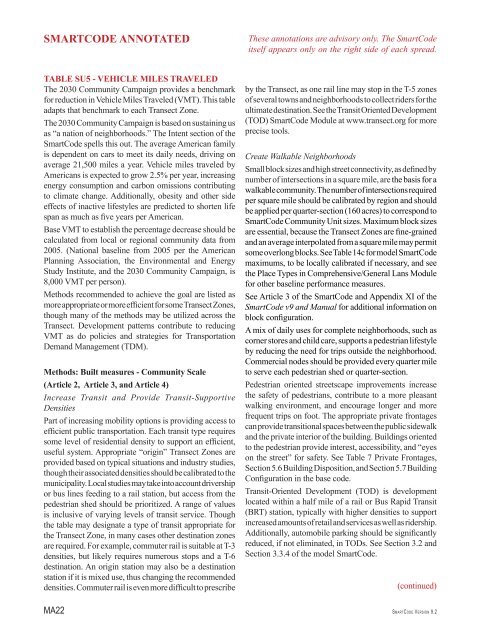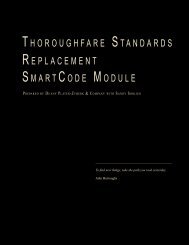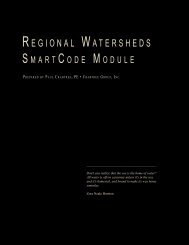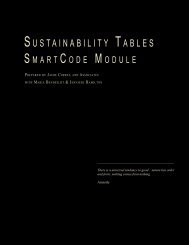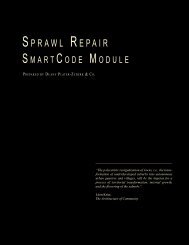U BANISM - Center for Applied Transect Studies
U BANISM - Center for Applied Transect Studies
U BANISM - Center for Applied Transect Studies
You also want an ePaper? Increase the reach of your titles
YUMPU automatically turns print PDFs into web optimized ePapers that Google loves.
SMARTCODE ANNOTATED<br />
These annotations are advisory only. The SmartCode<br />
itself appears only on the right side of each spread.<br />
Table su5 - Vehicle Miles Traveled<br />
The 2030 Community Campaign provides a benchmark<br />
<strong>for</strong> reduction in Vehicle Miles Traveled (VMT). This table<br />
adapts that benchmark to each <strong>Transect</strong> Zone.<br />
The 2030 Community Campaign is based on sustaining us<br />
as “a nation of neighborhoods.” The Intent section of the<br />
SmartCode spells this out. The average American family<br />
is dependent on cars to meet its daily needs, driving on<br />
average 21,500 miles a year. Vehicle miles traveled by<br />
Americans is expected to grow 2.5% per year, increasing<br />
energy consumption and carbon omissions contributing<br />
to climate change. Additionally, obesity and other side<br />
effects of inactive lifestyles are predicted to shorten life<br />
span as much as five years per American.<br />
Base VMT to establish the percentage decrease should be<br />
calculated from local or regional community data from<br />
2005. (National baseline from 2005 per the American<br />
Planning Association, the Environmental and Energy<br />
Study Institute, and the 2030 Community Campaign, is<br />
8,000 VMT per person).<br />
Methods recommended to achieve the goal are listed as<br />
more appropriate or more efficient <strong>for</strong> some <strong>Transect</strong> Zones,<br />
though many of the methods may be utilized across the<br />
<strong>Transect</strong>. Development patterns contribute to reducing<br />
VMT as do policies and strategies <strong>for</strong> Transportation<br />
Demand Management (TDM).<br />
Methods: Built measures - Community Scale<br />
(Article 2, Article 3, and Article 4)<br />
Increase Transit and Provide Transit-Supportive<br />
Densities<br />
Part of increasing mobility options is providing access to<br />
efficient public transportation. Each transit type requires<br />
some level of residential density to support an efficient,<br />
useful system. Appropriate “origin” <strong>Transect</strong> Zones are<br />
provided based on typical situations and industry studies,<br />
though their associated densities should be calibrated to the<br />
municipality. Local studies may take into account drivership<br />
or bus lines feeding to a rail station, but access from the<br />
pedestrian shed should be prioritized. A range of values<br />
is inclusive of varying levels of transit service. Though<br />
the table may designate a type of transit appropriate <strong>for</strong><br />
the <strong>Transect</strong> Zone, in many cases other destination zones<br />
are required. For example, commuter rail is suitable at T-3<br />
densities, but likely requires numerous stops and a T-6<br />
destination. An origin station may also be a destination<br />
station if it is mixed use, thus changing the recommended<br />
densities. Commuter rail is even more difficult to prescribe<br />
by the <strong>Transect</strong>, as one rail line may stop in the T-5 zones<br />
of several towns and neighborhoods to collect riders <strong>for</strong> the<br />
ultimate destination. See the Transit Oriented Development<br />
(TOD) SmartCode Module at www.transect.org <strong>for</strong> more<br />
precise tools.<br />
Create Walkable Neighborhoods<br />
Small block sizes and high street connectivity, as defined by<br />
number of intersections in a square mile, are the basis <strong>for</strong> a<br />
walkable community. The number of intersections required<br />
per square mile should be calibrated by region and should<br />
be applied per quarter-section (160 acres) to correspond to<br />
SmartCode Community Unit sizes. Maximum block sizes<br />
are essential, because the <strong>Transect</strong> Zones are fine-grained<br />
and an average interpolated from a square mile may permit<br />
some overlong blocks. See Table 14c <strong>for</strong> model SmartCode<br />
maximums, to be locally calibrated if necessary, and see<br />
the Place Types in Comprehensive/General Lans Module<br />
<strong>for</strong> other baseline per<strong>for</strong>mance measures.<br />
See Article 3 of the SmartCode and Appendix XI of the<br />
SmartCode v9 and Manual <strong>for</strong> additional in<strong>for</strong>mation on<br />
block configuration.<br />
A mix of daily uses <strong>for</strong> complete neighborhoods, such as<br />
corner stores and child care, supports a pedestrian lifestyle<br />
by reducing the need <strong>for</strong> trips outside the neighborhood.<br />
Commercial nodes should be provided every quarter mile<br />
to serve each pedestrian shed or quarter-section.<br />
Pedestrian oriented streetscape improvements increase<br />
the safety of pedestrians, contribute to a more pleasant<br />
walking environment, and encourage longer and more<br />
frequent trips on foot. The appropriate private frontages<br />
can provide transitional spaces between the public sidewalk<br />
and the private interior of the building. Buildings oriented<br />
to the pedestrian provide interest, accessibility, and “eyes<br />
on the street” <strong>for</strong> safety. See Table 7 Private Frontages,<br />
Section 5.6 Building Disposition, and Section 5.7 Building<br />
Configuration in the base code.<br />
Transit-Oriented Development (TOD) is development<br />
located within a half mile of a rail or Bus Rapid Transit<br />
(BRT) station, typically with higher densities to support<br />
increased amounts of retail and services as well as ridership.<br />
Additionally, automobile parking should be significantly<br />
reduced, if not eliminated, in TODs. See Section 3.2 and<br />
Section 3.3.4 of the model SmartCode.<br />
(continued)<br />
MA22 S m a r t C o d e Ve r s i o n 9.2


